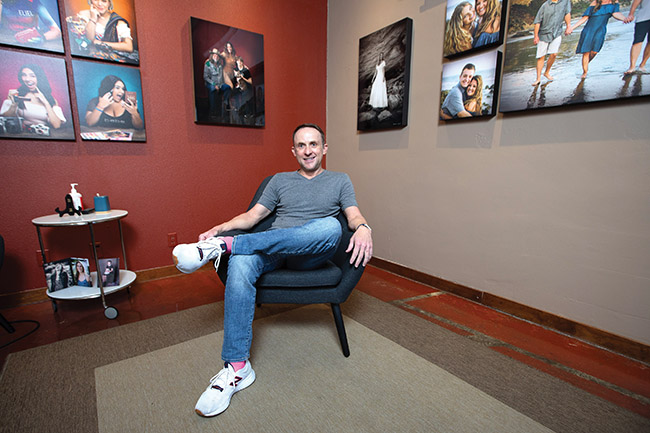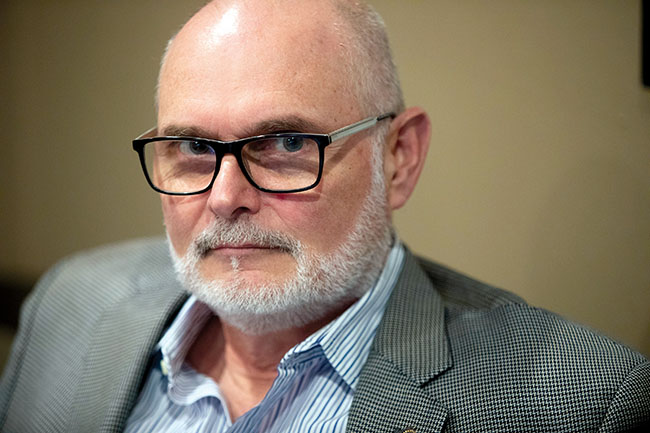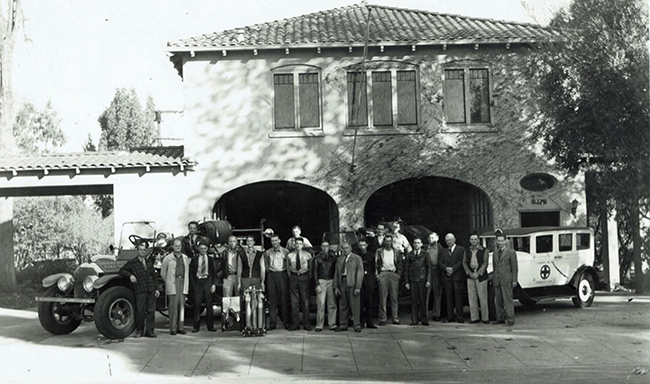New year? How about a new debt-free you?

During the Great Recession, Claremont photographer Michael Negrete found himself with $60,000 in credit card debt and very little income. Through hard work and some big lifestyle changes he paid it off in two years. Courier photo/Steven Felschundneff
by Steven Felschundneff | steven@claremont-courier.com
If you recently made a New Year’s resolution, it likely had to do with improved health and fitness. But a recent survey from Forbes Health found that the second most common resolution, one identified by 38% of respondents, was to improve one’s finances and start saving for the future.
For many people, saving money feels impossible, simply because they live paycheck to paycheck. And a major contributing factor to spending everything you earn is burdensome debt payments.
If you are feeling the financial pinch of excessive debt, you are not alone. According to a report from the Federal Reserve Bank of New York’s Center for Microeconomic Data, aggregate household debt balances in the United States increased by $228 billion in the third quarter of 2023, resulting in a record $17.29 trillion total debt nationwide.
The vast majority of that, $12.49 trillion, is housing debt, a result of the double punch of rapidly increasing interest rates and the high cost buying a home. Yet that leaves another $4.8 trillion in other types of debt, most commonly credit card balances, student loans, and car payments.
Despite those large numbers, most people are current on their loans, particularly here in California, where the number of balances that are severely late — 90 days or more past due — is just over 1%. However, California leads the pack when it comes to total debt per capita at roughly $85,000.
So, if your resolution is to get out from under mounting debts, how does one begin?
“The first line of defense against debt is to have a budget,” Claremont financial advisor Ronald Coleman said. “Basically knowing what is coming in and what is going out is going to at least get everything into focus so you can actually set up a plan.”

Financial advisor Ron Coleman says the first step to getting out of debt is creating a budget. Courier photo/Steven Felschundneff
When working with a client who has some debt, Coleman asks them to separate their finances into “needs, wants, and wishes.” “Needs” include necessities like housing, utilities, and food. He advises that no money goes to “wants” and “wishes” until the “needs” are first addressed.
Next, he recommends setting aside 10% of one’s income monthly into some type of savings account to pay for unexpected expenses.
“This way once you do run into tough times or you need a new radiator in the car you are not dipping into the credit card because you have a cushion,” Coleman said.
He admits that may not be possible for everyone. “In some cases if the debt is really debilitating, having a cushion is a luxury.”
Once you have a budget it’s easier to identify the money you can commit to debt payments and then adopt a game plan. One strategy is to put the bulk of your cash toward paying the card with the lowest balance, while making minimum payments on the rest. The idea is that paying off that first card will reinforce the feeling of making progress, which can be a strong motivator.
Another approach is to pay the card with the highest interest rate first, limiting the amount of money that is going toward interest. This strategy becomes even more attractive when interest rates are on the rise.
“In the past year and-a-half when the [Federal Reserve] has raised the interest rates so fast in such a short period of time, it’s put a terrible squeeze on people, especially those who have revolving credit debt,” Coleman said.
Homeowners with some equity can take out a line of credit, which typically has a much lower interest rate than credit cards, while offering the convenience of making a single payment.
“One line of defense is to work with a company that would consolidate the loans and pay a monthly payment and try to negotiate a lower fee,” Coleman said. “There are a lot of red flags in that arena because, just like the credit card company that signed you up, there are people who are just looking to make money.”
He recommends checking with the Consumer Financial Protection Bureau to locate companies that are truly nonprofit, as well as the Federal Trade Commission’s Consumer Advice division.
Local commercial photographer Michael Negrete achieved the dream of paying off all his debt, but it required a full-on change in lifestyle.
When Negrete was in his mid 30s he was running a successful portrait studio and earning a six-figure income. During that time if he had travel expenses, or needed to buy camera equipment, out came the card. It was just part of running the studio. Every month he made payments to his creditors but eventually ran up about $60,000 in unsecured debt.
“I was probably making 120 grand a year, but like most people, I had credit card debt. But I didn’t think anything about it because of the amount of money I was bringing in every month. I would pay quite a bit towards the debt every month, but I never paid it off,” Negrete said. “Then comes the 2009 housing crash and people stop buying photography and I go from bringing in $10,000 month to months when I brought in $1,000 or less. So basically overnight I was unable to make those minimum payments.”
Around that same time he started listening to controversial finance personality Dave Ramsey’s radio show, which preaches the gospel of the debt-free lifestyle.
“But the thing that kind of hit me was he basically said you have to be willing to do some hard things to get out of debt,” Negrete said. “And I also started looking at the math and realizing even if you make double the minimum payment on your credit card, you are going to be paying them forever, and will turn that $30,000 debt into $50,000 because of the interest. You will always be making the payments, and you will always be poor.”
Negrete found someone to take over his car payment and purchased an $1,800 Honda Accord. Negrete and his two young sons stopped going out to dinner and lived on bean and cheese burritos.
“Having no car payment and not going out to dinner, all of a sudden you have freed up, say, six to eight hundred dollars a month. And I just did what [Ramsey] suggested, I paid off the smallest debt first. I started calling some of the credit card companies and saying, ‘Hey, I am in trouble here, can I negotiate?’” Negrete said, “And they did. Some of them cut the debt in half.”
It took two years of constant sacrifice, but Negrete eventually found his way out of debt. He has not gone back to his old lifestyle of overspending. Instead, he takes the money he once was giving to his creditors and invests it in his retirement accounts.










0 Comments